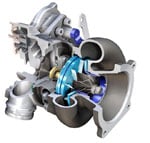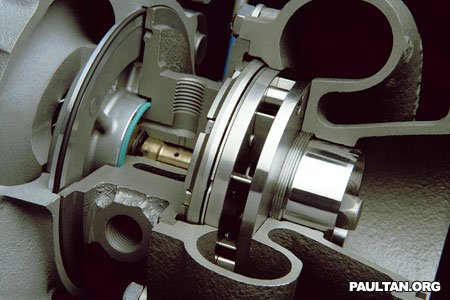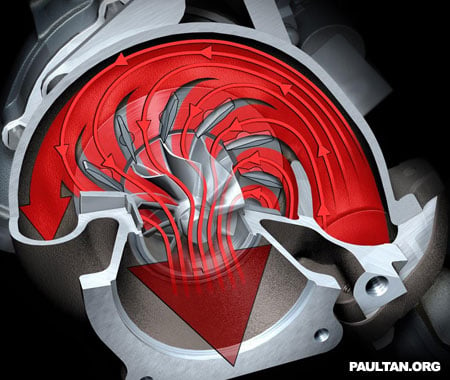 Variable Turbine Geometry technology is the next generation in turbocharger technology where the turbo uses variable vanes to control exhaust flow against the turbine blades. See, the problem with the turbocharger that we’ve all come to know and love is that big turbos do not work well at slow engine speeds, while small turbos are fast to spool but run out of steam pretty quick. So how do VTG turbos solve this problem?
Variable Turbine Geometry technology is the next generation in turbocharger technology where the turbo uses variable vanes to control exhaust flow against the turbine blades. See, the problem with the turbocharger that we’ve all come to know and love is that big turbos do not work well at slow engine speeds, while small turbos are fast to spool but run out of steam pretty quick. So how do VTG turbos solve this problem?
A Variable Turbine Geometry turbocharger is also known as a variable geometry turbocharger (VGT), or a Variable Nozzle Turbine (VNT). A turbocharger equipped with Variable Turbine Geometry has little movable vanes which can direct exhaust flow onto the turbine blades. The vane angles are adjusted via an actuator. The angle of the vanes vary throughout the engine RPM range to optimize turbine behaviour.

In the 3D illustration above, you can see the vanes in a angle which is almost closed. I have highlighted the variable vanes so you know which is which. This position is optimized for low engine RPM speeds, pre-boost.

In this cut-through diagram, you can see the direction of exhaust flow when the variable vanes are in an almost closed angle. The narrow passage of which the exhaust gas has to flow through accelerates the exhaust gas towards the turbine blades, making them spin faster. The angle of the vanes also directs the gas to hit the blades at the proper angle.

Above are how the VGT vanes look like when they are open. I’ve not highlighted where the vanes are in this image since you already know where they are, as to not spoil the mechanical beauty that it is :P

This cut-through diagram shows the exhaust gas flow when the variable turbine vanes are fully open. The high exhaust flow at high engine speeds are fully directed onto the turbine blades by the variable vanes.
Variable Turbine Geometry has been used extensively in turbodiesel engines since the 1990s, but it has never been on a production petrol turbocharged car before until the new Type 997 Porsche 911 Turbo. This is because petrol engine exhaust gases are alot hotter than diesel engine exhaust gas, so generally the material used to make VTG turbos could not stand this heat. The 997 911 Turbo uses a BorgWarner VTG turbocharger which uses special materials derived from aerospace technology, hence solving the temperature problem.
I hope I have helped you understand how VTG works. Watch out for full tech details on the new Porsche 911 Turbo.
Looking to sell your car? Sell it with Carro.




AI-generated Summary ✨
The comments generally express appreciation for the detailed explanations of Variable Turbine Geometry (VGT) and related turbo technologies, highlighting its innovative function of controlling exhaust flow via vanes to optimize engine performance and reduce turbo lag. Some comments clarify that VGT is not the same as Variable Valve Timing (VVT), emphasizing the distinct roles of turbo and engine valve technologies. Several replies note that the system is electronically controlled, responding dynamically to engine demands, with some sharing insights from engineering backgrounds or previous experiences. A few off-topic comments reference related turbo technologies, industry applications, or historical usage, while others wish for visual animations or technical papers for deeper understanding. Overall, sentiments are positive, highlighting the sophistication and benefits of VGT technology in modern turbocharged engines.